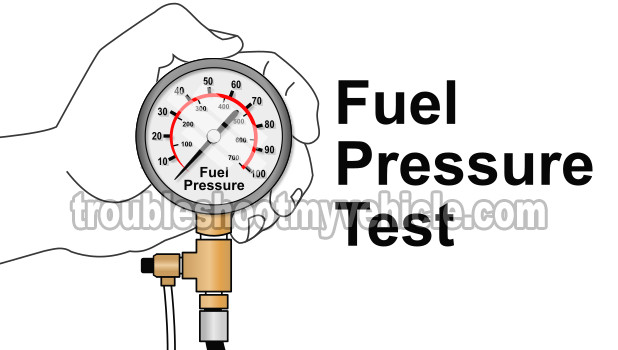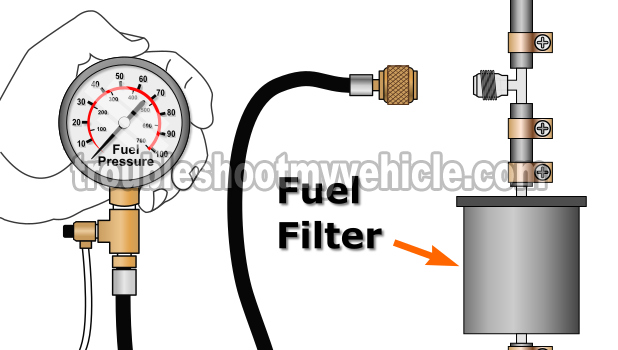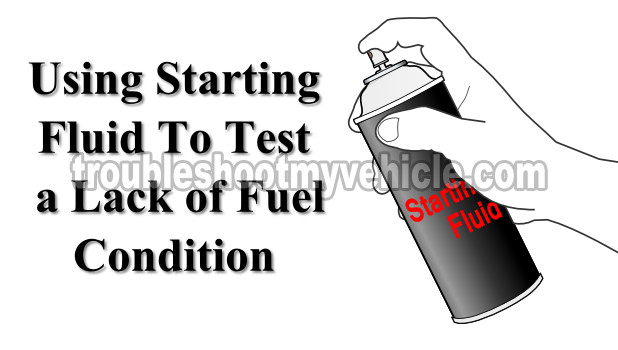
You can accurately test the fuel pump, on your 1.6L Nissan Sentra, to see if it has failed and thus keeping your car from starting or just not sending enough fuel to the engine to keep it running optimally.
In this tutorial, I'll show you how and where to connect your fuel pressure test gauge and what fuel pressure specification you should see. I'm also gonna' explain a simple and easy way to confirm a 'lack of fuel' condition by using starting fluid.
Contents of this tutorial:
ES ![]() You can find this tutorial in Spanish here: Cómo Verificar La Bomba de Combustible (1.6L Nissan Sentra) (at: autotecnico-online.com).
You can find this tutorial in Spanish here: Cómo Verificar La Bomba de Combustible (1.6L Nissan Sentra) (at: autotecnico-online.com).
NOTE: This tutorial applies to the following vehicles:
- 1.6L Nissan Sentra: 1995, 1996, 1997, 1998, 1999.
ENGINE NO-START DIAGNOSTICS: The following tutorial may be of help in troubleshooting a 'cranks but does not start' condition: How To Troubleshoot A No Start (1.6L Nissan)
Symptoms Of A Bad Fuel Pump
Fuel pump failures usually fall into one of two categories. In the most common type of failure, the fuel pump just stops working completely and the engine doesn't start at all. In the second type of failure, the fuel pump works just enough to start and keep the engine running, but the engine runs rough.
When a fuel pump completely fails, you'll see that:
- The engine turns over but will not start.
- All 4 cylinders are being fed spark (as checked by a spark tester).
- Your Nissan Sentra's fuel injection computer is activating all 4 fuel injectors (as checked with a Noid light).
- Fuel pressure PSI is 0 PSI when checked with a fuel pressure test gauge.
- Engine starts, although momentarily, if you spray starting fluid into the throttle body and then crank the engine.
When the fuel pump is starting to fail and under-performing, you'll probably see one or more of the following symptoms:
- Lean air/fuel mixture trouble codes.
- Rough idle.
- Engine starts after extended cranking.
- Lack of power when accelerating the vehicle down the road.
- Back-fires thru' the intake manifold when accelerating your Nissan Sentra down the road.
Both of these conditions can be tested with a fuel pressure gauge. Alright, with this info under our belts, let's get testing.
Where To Buy A Fuel Pressure Test Gauge
You can buy a fuel pressure test gauge just about anywhere and is one of the most important tools any serious DIY'er should have in his/her tool box.
The following fuel pressure test gauge kits are pretty good deals and include the adapter to test your 1.6L Nissan Sentra (they also include all of the adapters to test GM and Ford vehicles equipped with a Schrader valve):
Disclosure: As an Amazon Associate, I earn from qualifying purchases. If my tutorials help you, using these links is an easy way to support the site at no extra cost to you. Thank you!
All of the fuel pump pressure test kits above have the fitting that will connect to your Nissan's fuel system.
TEST 1: Checking Fuel Pressure With A Fuel Pressure Gauge

To connect the fuel pressure gauge, to your 1.6L Nissan Sentra, you'll need to tap into the fuel hose that connects the fuel injector rail to the fuel filter. This requires the use of a special T adapter as illustrated in the illustration above.
You can see a photo of the fuel filter's output hose here: Location Of Fuel Filter Output Hose. The fuel pressure specification (with the engine running) is:
| Without Vacuum to Fuel Pressure Reg. | With Vacuum to Fuel Pressure Reg. |
|---|---|
| 43 PSI | 34 PSI |
Now, if your Nissan Sentra's engine doesn't start, use the 43 PSI value as your specification.
NOTE: If you don't have a fuel pressure gauge, take a look at the section: Where To Buy A Fuel Pressure Test Gauge.
OK, let's get started with this test:
- 1
Release the fuel pressure built up inside the fuel line. You can accomplish by removing the fuel pump relay and cranking the engine for about 5 seconds.
- 2
Place a shop towel around the fuel filter and disconnect the output fuel hose. The shop towel's job is to absorb any fuel that may leak when disconnecting the fuel hose.
- 3
Install the T adapter and any additional fuel hoses (that come in the fuel pressure test kit) to the fuel filter. Tighten all hose clamps. Your set-up should look like the illustration above.
- 4
Re-install the fuel pressure relay and ask your helper to cycle the key on and off but don't crank the engine while you observe the fuel pressure tester's gauge.
Check your T-adapter connections for fuel leaks and if any tighten the hose clamps a bit more to eliminate them. - 5
Your fuel pressure gauge should register about 43 PSI fuel pressure if the fuel pump is OK.
Let's take a look at what your results mean:
CASE 1: The fuel pressure gauge registered 0 PSI. This confirms that the cause of your 1.6L Nissan Sentra no-start problem is caused by a lack of fuel.
Now, I usually take 2 more precautions, before condemning the fuel pump as bad:
- Making sure the fuel pump fuse is feeding the fuel pump power (if the fuel pump fuse is blown, then the fuel pump will not run).
- Making sure the fuel pump relay is feeding the fuel pump power (if the fuel pump relay is bad, then the fuel pump will not run).
CASE 2: The fuel pressure gauge registered the specified fuel pressure for your vehicle's model year. This test result lets you know that the fuel pump is working and delivering enough fuel to the fuel injectors. The reason your 1.6L Nissan Sentra is not starting is due to another reason. The fuel pump is OK.
TEST 2: Using Starting Fluid To Confirm Lack Of Fuel

If your Nissan Sentra doesn't start, the first test I'm gonna' suggest to you is the starting fluid test. Using starting fluid to find out if the fuel pump has stopped working is fast and easy (although it's not the most accurate way to diagnose a bad fuel pump).
But before you start this test, you first have to make sure that all 4 spark plug wires are delivering spark to their respective spark plugs. This means you need to do a spark test, with a spark tester, first.
IMPORTANT: This is a very fast and easy test but you do have to take one very important safety precaution and this is to reconnect the air intake duct after spraying starting fluid down the throttle bore (although you don't have to fasten it). This will prevent any backfire, that might occur, from scaring the heck out of you when cranking the engine.
This is what you have to do:
- 1
Remove the intake air duct from the throttle body. You don't have to completely remove it, since you'll have to reconnect it in one of the next steps.
- 2
Open the throttle plate and spray starting fluid down the bore.
As a safety precaution reconnect the air duct after you have sprayed a good squirt of starting fluid (but you don't have to tighten the air duct's hose clamp). - 3
Crank the engine once the air duct is back on and you're clear of the engine compartment.
- 4
The engine will start momentarily and after a few seconds will die if the fuel pump is not working.
If the fuel pump is working, and thus sending fuel to the fuel injectors, then the engine won't start at all.
OK, let's find out what your results mean:
CASE 1: The engine started and ran for a few seconds. This test result tells you that the no-start problem is due to a lack of fuel.
Your next step is to check to see what the fuel pressure is with a fuel pressure test gauge. Go to: TEST 1: Checking Fuel Pressure With A Fuel Pressure Gauge.
CASE 2: The engine did not start, not even momentarily. This usually means that a lack of fuel IS NOT the reason your car is not starting.
Now, remember what I said about this test not being very accurate? Well, I suggest you do one more test and this is to check the fuel pressure with a fuel pressure test gauge. Go to: TEST 1: Checking Fuel Pressure With A Fuel Pressure Gauge.
Location Of Fuel Filter Output Hose

NOTE: The photo above is of a 1999 1.6L Nissan Sentra's fuel filter.
The fuel filter's output fuel hose connects to the fuel injector rail and this is the hose you'll need to disconnect to install your fuel pressure tester's T-adapter.
Where To Buy The Fuel Pump And Save
The fuel pump in your 1.6L Nissan Sentra is located inside the fuel tank. The fuel pump can be bought in any auto parts store, but I think you'll find the better price online. The following fuel pumps are pretty good deals:
Disclosure: As an Amazon Associate, I earn from qualifying purchases. If my tutorials help you, using these links is an easy way to support the site at no extra cost to you. Thank you!
Not sure if the above fuel pumps fit your particular 1.6L Nissan Sentra? Don't worry, once you get to the site, they'll make sure it fits by asking you the specifics of your vehicle. If it doesn't fit, they'll find you the right one.
More 1.6L Nissan Tutorials
You can find a complete list of tutorials in this index: Nissan 1.6L Index Of Articles.
Here's a small sample of the 1.6L Nissan tutorials you'll find in the index:
- How To Test Engine Compression (1.6L Nissan).
- How To Test The TPS (1997-1999 1.6L Nissan Sentra).
- How To Test The Idle Switch (1997-1999 1.6L Nissan Sentra).
- How To Troubleshoot A No Start (1.6L Nissan).
- Mass Air Flow (MAF) Sensor Test Nissan Sentra 1.6L (1995-1999) (at: easyautodiagnostics.com).

If this info saved the day, buy me a beer!







